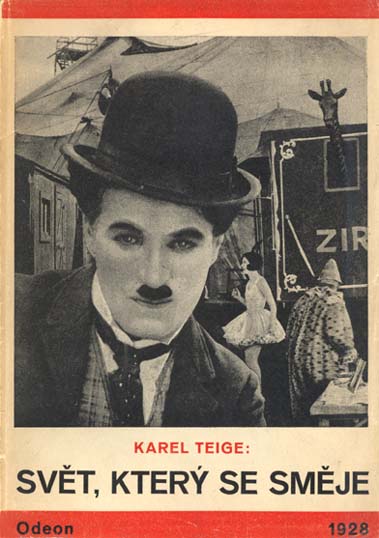Karel Teige: O humoru, clownech a dadaistech, I-II (1928-30/2004) [Czech]
Filed under book | Tags: · aesthetics, art, art theory, avant-garde, circus, dada, film, humour, poetry, surrealism, theatre


Dvousvazková kultovní práce vůdčího teoretika české avantgardy je unikátní studií o dadaismu.
První svazek obsahuje kapitoly “pojednávající o humoru, o světském a neliterárním dadaismu a o poezii cirkusu, music-hallu a lunaparku”. Druhý svazek “kreslí svět moderní básně, svět, který voní; podává genezi dadaismu přehledem vývoje od Baudelairea až k Tzarovi, charakteristiku hnutí dada i surrealistické revoluce a v závěru pokouší se formulovat teorii a estetiku nové poezie pro všecky smysly, podloženou fakty korespondence a analogie mezi jednotlivými obory ‘umění’..”, to, co “je jádrem nové estetické teorie, která se zve poetismem”. S doslovem Jiřího Brabce.
O humoru, clownech a dadaistech, I: Svět, který se směje
Originally published by Odeon, Prague, 1928, 112 pp
Publisher Akropolis, Prague, 2004
ISBN 8073040425
114 pages
O humoru, clownech a dadaistech, II: Svět, který voní
Originally published by Odeon, Prague, 1930, 240 pp
Publisher Akropolis, Prague, 2004
ISBN 8073040530, 9788073040536
244 pages
review (Vol. 1, Andrea Jochmanová, Literární noviny, in Czech)
review (Vol. 2, Jan Nejedlý, Čro Vltava, in Czech)
Klaxon: mensário de arte moderna, No. 1-9 (1922-23) [Portuguese]
Filed under magazine | Tags: · art, avant-garde, brazil, futurism, poetry

Lançada em São Paulo no mesmo ano que se realiza a Semana de Arte Moderna, Klaxon (1922-1923) é a primeira revista modernista do Brasil.
Em “O Alegre combate de Klaxon”, excelente introdução á edição fac-similar da revista, Mário da Silva Brito afirma que “em Klaxon aparece, sob forma de artigos, poemas, comentários, críticas de arte, piadas e farpas zombeteiras, o estado de espírito do grupo de jovens que elaborou a ideologia modernista”. Do comitê de redação, participam ativamente Menotti del Picchia e Guilherme de Almeida. Porém , ainda que a revista não o registre de forma explícita, sabe-se hoje, por intermédio de Aracy Amaral, que Mário de Andrade foi “diretor e líder da revista“. Mesmo assim, de um número para outro prevalece o espírito de grupo anunciado no texto introdutório : “KLAXON tem uma alma coletiva”. Essa apresentação tem todas as características de um manifesto e, embora venha assinada pela Redação, ela é, segundo Mário da Silva Brito, de autoria de Mario de Andrade. (source)
Published in São Paulo, Brazil
via Brasiliana USP
commentary (Jorge Schwartz, in Portuguese)
Klaxon at Wikipedia (in Portuguese)
PDF (all issues, ZIP)
Download Issue 1 (May 1922), Issue 2 (June 1922), Issue 3 (July 1922), Issue 4 (Aug 1922), Issue 5 (Sep 1922), Issue 6 (Oct 1922), Issue 7 (Nov 1922), Issue 8-9 (Dec 1922-Jan 1923).
Lucy R. Lippard: Get the Message? A Decade of Art for Social Change (1984)
Filed under book | Tags: · 1970s, activism, art, art criticism, art theory, avant-garde, collage, dada, feminism, left, photography, politics, pop art

“This book is the third collection of essays I’ve published in a little over a decade. Each of my books has marked the beginning of a specific phase of my life, though not necessarily its end. Changing (1971) was the product of my ‘formalist’ or art-educational period; it consisted primarily of essays written from 1965 to 1968, with a few late additions foreshadowing my next book-Six Years: The Dematerialization of the Art Object.. (1973). From the Center (1976) and Eva Hesse (1976) documented my developing conversion to feminism, which expanded all the possibilities that had seemed to be closing down in the ‘cultural confinement’ of the early 1970s. Get the Message? is the result of a need to integrate the three sometimes contradictory elements of my public (and often private) life-art, feminism, left politics. Owing to publication delays, only two essays from the last two years are included.” (introductory note from the author)
Publisher E.P. Dutton, 1984
ISBN 0525480374, 9780525480372
343 pages
via fiona
Review: Fred Pfeil (Minnesota Review, 1985).
PDF (19 MB)
Comment (0)
